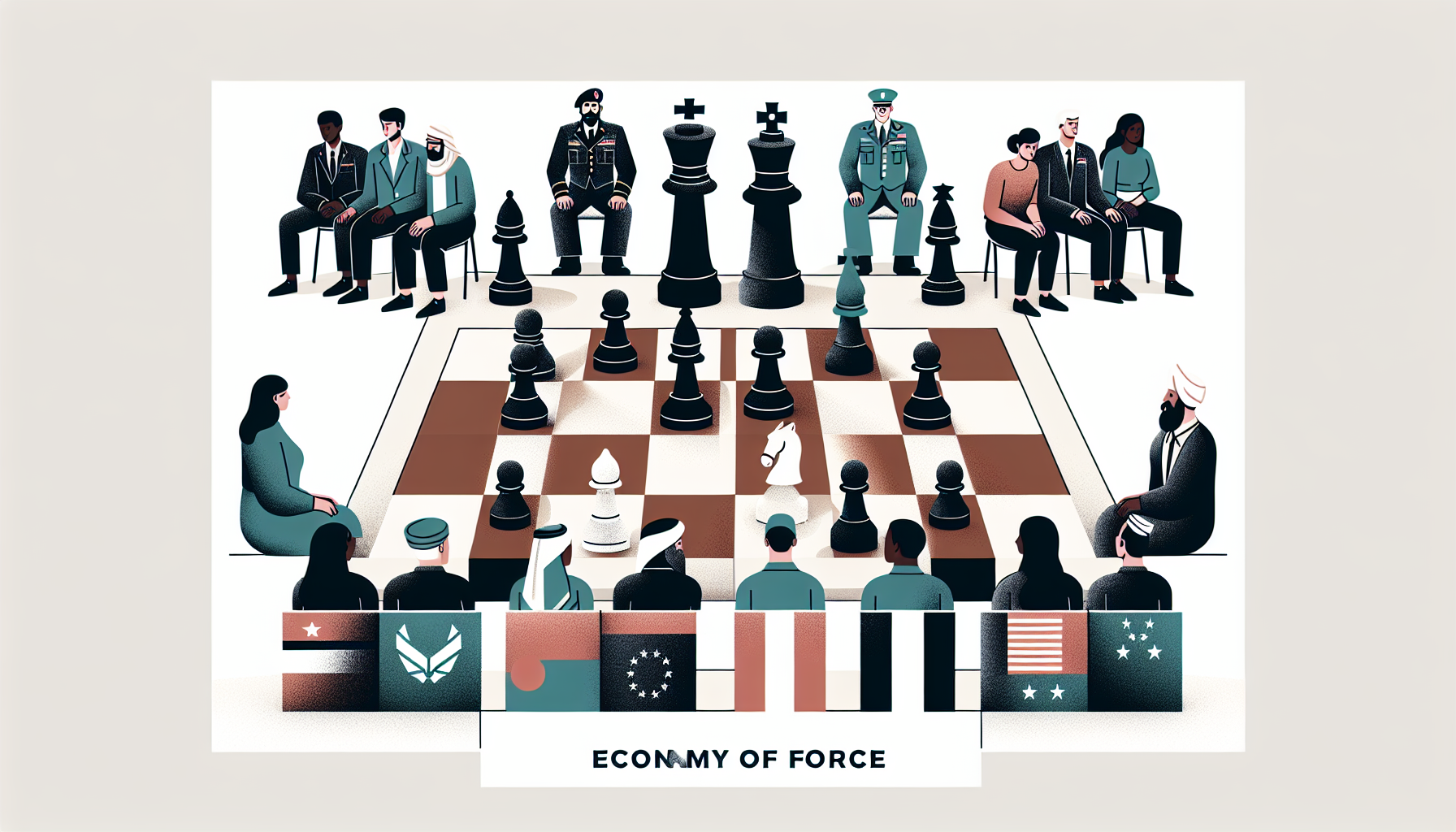Definition
“Economy of force” is a military directive that refers to the principle of using minimum resources and effort to achieve a specific goal. Essentially, it calls for allocating resources efficiently, aiming to win the greatest advantage with the least necessary expenditure. This tactic enables forces to concentrate their strength in more critical areas while maintaining minimum effort elsewhere.
Key Takeaways
- Economy of force refers to a principle of war where the superior allocation and careful management of limited resources (like manpower, weapons, etc.) are employed to achieve maximum possible outcomes. The idea is to use minimal effort and expenditure to achieve the desired result.
- This concept involves strategies like distracting opponents with minor forces while concentrating major forces elsewhere, often achieving surprise and lessening the chance of a major clash. This is done without leaving any crucial sectors uncovered or any vulnerabilities that can be exploited by the enemy.
- Lastly, economy of force is a delicate balance. While it is important to allocate resources and forces economically, it demands careful planning, excellent situational awareness, and competent leadership to ensure forces are not spread too thinly, which could undermine operational objectives or cause mission failure.
Importance
Economy of force is a crucial principle in military operations as it emphasizes the judicious use of resources.
The principle advocates for minimizing the commitment of resources, i.e., manpower, equipment, and time for secondary objectives so more can be allocated to primary objectives.
This ultimately results in greater efficiency and optimization of resources, reduces wastage, and allows for the allocation of the majority of one’s strength on vital tasks.
This not only maximizes military potential and effectiveness, but it also incurs the least cost on resources, thereby capitalizing on the element of strategy in military operations.
Simply put, economy of force is about achieving maximum effect with minimum effort, pointing towards the crucial role of strategy and planning in military operations.
Explanation
The principle of economy of force is one of the key fundamental guidelines in military strategy. Its central purpose is to aid in the effective allocation and use of resources in any given military operation. This principle insists on prudent employment and carefully measured allocation of force on secondary objectives, to conserve resources and maintain the capability to concentrate maximum force on primary objectives.
The principle of economy of force is used as a strategic tool to ensure maximum efficacy of military operations. By applying minimum essential combat power on secondary efforts, commanders can vastly concentrate their forces on the decisive operation. Consequentially, it results in making the most effective use of available resources.
In simple terms, it’s a matter of prioritizing and using resources wisely. For example, if there’s a smaller threat that can be reasonably contained, it would receive less attention compared to a significant threat that could potentially hinder the accomplishment of the overall mission if left unaddressed. However, it’s important to note that such decisions require careful strategic planning and risk management to ensure achieving the desired balance between economy and effectivity.
Examples of Economy of force
Operation Desert Storm (1991): In this operation, the US-led coalition against Iraq demonstrated the economy of force. Instead of deploying a multitude of ground forces initially, they first implemented a prolonged air campaign to weaken Iraq’s defenses. By utilizing superior airpower and precise targeting, they effectively minimized the use of additional resources and unnecessary ground forces, using minimal force to achieve maximum results.
D-Day Invasion (1944): The Allied forces used the concept of economy of force during the D-Day invasion in World War II. Instead of launching a full-scale attack all along the German-occupied French coastline, they focused the main attack on Normandy. Meanwhile, they conducted deceptive operations elsewhere to distract the Germans, thereby using fewer troops and resources to achieve a significant strategic goal.
Battle of Midway (1942): In this pivotal naval battle during World War II, the US Navy demonstrated the economy of force against the Japanese fleet. Aware that they were outnumbered, the US forces focused their power on sinking Japan’s aircraft carriers – the heart of their Pacific fleet. By targeting these key assets, they managed to turn the tide of the war in the Pacific with relatively limited forces, thereby using their resources economically.
FAQs about Economy of Force
What is the Economy of Force in Military Operations?
The Economy of Force is a principle of war that instructs commanders to use minimal resources and effort on secondary objectives so that the maximum force can be deployed on primary objectives. This is crucial in warfare to ensure no effort or resources are wasted.
Why is Economy of Force Important?
Economy of force plays an essential role in military operations. The proper allocation of resources can make the difference between victory and defeat. This principle ensures that every asset is put to its best possible use to achieve the main objective.
Is Economy of Force applicable only to Military Operations?
No, while it is primarily a military term, the principle of economy of force can also be applicable in various fields such as business, crisis response, or even everyday strategizing. It generally signifies the efficient use of resources to achieve the desired goal.
How does Economy of Force work in real-life military contexts?
An instance of economy of force could be diverting the majority of your troops to a major battle while leaving a small group to guard other areas. The key is to use the smallest amount of resources necessary to maintain security and achieve secondary objectives so that maximum resources can be devoted to the primary objective.
Related Military Operation Terms
- Commander’s intent: Commander’s intent refers to a concise expression of the purpose of the operation and the desired end state. It helps subordinates understand the larger implications of their actions.
- Principle of War: Economy of force is one of the principles of war. These principles guide war strategies and tactics, including how forces are utilized during a conflict.
- Military strategy: This term denotes the planning and conduct of campaigns, the movement and disposition of forces, and the deception of the enemy.
- Force allocation: Force allocation represents the distribution of available military resources to the various military operations, tasks, or roles.
- Military doctrine: Economy of force falls within a military’s doctrine, which outlines how the military functions and fights.
Sources for More Information
- U.S. Army Official Website : This is an official site of The United States Army where one can get trusted information about the concept of ‘Economy of force’ in military operations.
- Encyclopedia Britannica : A trusted information source that often includes detailed insight on a wide range of topics, including military strategy and tactics such as ‘Economy of force’.
- U.S. Marine Corps Official Website : This website hosts reliable information about the tactics and strategies used in the U.S. Marine Corps, which likely includes the concept of ‘Economy of force’.
- Joint Chiefs of Staff Official Website : By visiting this website, you should be able to fact-check the concept under the doctrine section which holds information about the strategies and tactics used in all US military services.
 Benefits.com Advisors
Benefits.com Advisors
With expertise spanning local, state, and federal benefit programs, our team is dedicated to guiding individuals towards the perfect program tailored to their unique circumstances.
Rise to the top with Peak Benefits!
Join our Peak Benefits Newsletter for the latest news, resources, and offers on all things government benefits.




















